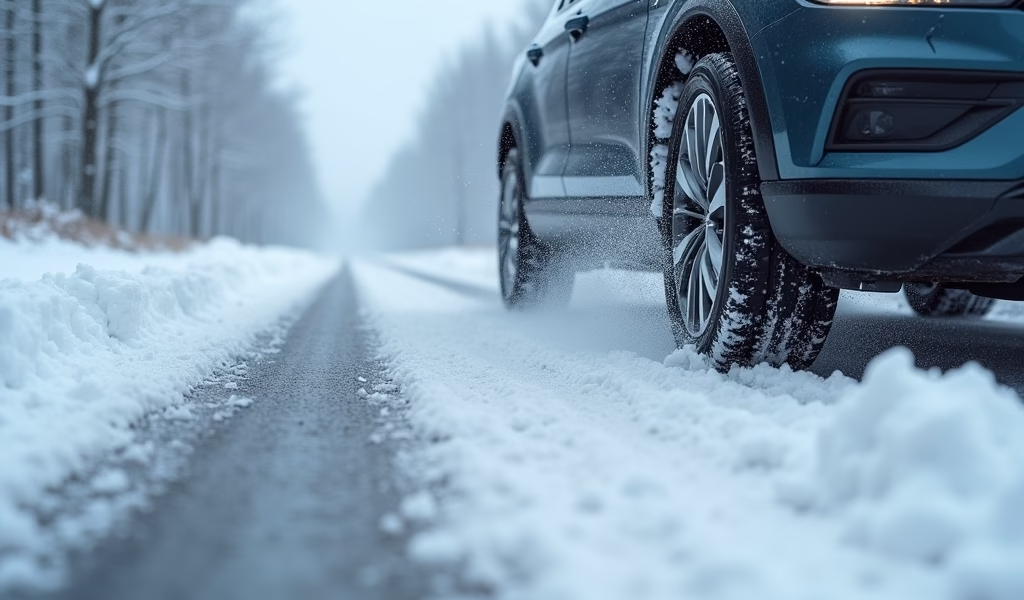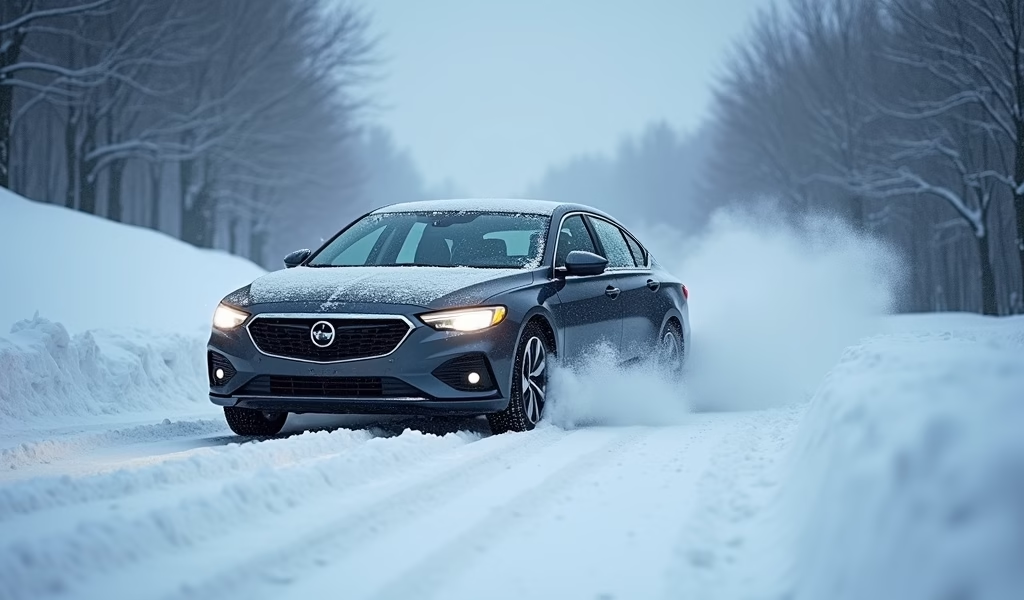Overview
This article provides essential guidance for driving front-wheel drive vehicles in snow, emphasizing that proper winter tires, gentle driving techniques, and vehicle preparation are more important than drivetrain type. It covers specific strategies like gradual acceleration, increased following distance, and proper braking techniques, while debunking misconceptions about FWD capabilities compared to AWD/4WD systems.
Table of Contents
- Understanding Front Wheel Drive in Winter Conditions
- How to Prepare Your FWD Vehicle for Snow
- 7 Proven Driving Techniques for FWD in Snow
- The Critical Importance of Proper Tire Selection
- Winter Maintenance Tips for FWD Vehicles
- Handling Emergency Situations in Snow
- How FWD Compares to Other Drivetrains in Snow
- Conclusion
- Frequently Asked Questions
Understanding Front Wheel Drive in Winter Conditions
Driving in snow with a front wheel drive vehicle doesn’t have to be a white-knuckle experience. As someone who’s spent decades working on vehicles and teaching winter driving techniques, I can tell you that front wheel drive in snow can actually offer some distinct advantages when handled properly. The fundamental design places the engine weight directly over the driving wheels, giving you better traction than you might expect.
Unlike rear-wheel drive vehicles, which can fishtail more easily, front wheel drive systems provide more predictable handling in slippery conditions. The physics are straightforward – when power is delivered to the front wheels, which are also handling steering, the car naturally wants to go in the direction the wheels are pointed. This makes recovery from slides more intuitive for most drivers.
That said, no drivetrain is magical in snow. The real secret to winter driving success combines vehicle preparation, proper technique, and understanding your car’s limitations. Even the most sophisticated FWD system won’t help if you’re running on bald all-season tires or driving too fast for conditions.
Let’s break down how to make the most of your front-driver when the snowflakes start falling, starting with some essential preparations that can make all the difference between confident winter driving and becoming another roadside statistic.
How to Prepare Your FWD Vehicle for Snow
Before the first snowfall hits, taking time to prepare your front wheel drive vehicle can save you countless headaches (and potentially dangerous situations). These preparations aren’t complicated, but they make an enormous difference in how your car performs when roads turn treacherous.
Start with a comprehensive winter check-up. Have your mechanic inspect your battery (cold weather reduces battery efficiency by up to 50%), antifreeze levels, heating system, and especially your brakes. Winter vehicle preparation isn’t just about convenience—it’s about safety when temperatures plummet.
Next, clean out unnecessary weight from your trunk, but do add a few strategic items. A small bag of cat litter or sand can provide emergency traction if you get stuck. Also include a folding shovel, ice scraper, jumper cables, flashlight, blanket, and snacks. Being prepared for the worst while hoping for the best is the winter driver’s mantra.
Consider adding weight directly over your front wheels. While your FWD vehicle already has engine weight there, a bit more can improve traction further. A couple of sandbags placed over the front axle (but secured so they won’t become projectiles in a collision) can give you that extra bit of grip when starting from a standstill.
Finally, take time to practice snow driving techniques in an empty, snow-covered parking lot before you need these skills in traffic. Get a feel for how your specific vehicle handles in low-traction situations, where the limits are, and how various inputs affect vehicle behavior. This hands-on experience is invaluable and cannot be replaced by reading tips alone.

7 Proven Driving Techniques for FWD in Snow
Now let’s get into the practical techniques that will keep you moving safely when the white stuff blankets your routes. These seven approaches have proven themselves through decades of winter driving experience.
1. Master the Gentle Start
When starting from a standstill on snow or ice, gentleness is key. Apply throttle gradually, almost as if you’re trying to move an egg without breaking it. If you hear or feel your wheels spinning, immediately back off the gas slightly. Starting in second gear (if you have a manual transmission) can help reduce torque to the wheels and prevent spin. For automatics, many newer vehicles have a “snow” or “winter” mode that does essentially the same thing.
2. Embrace Anticipation
The single most important winter driving skill is looking far ahead and anticipating what’s coming. Increase your following distance to at least 8-10 seconds in snow (instead of the normal 3-4 seconds). Begin slowing for stops, turns, and potential hazards much earlier than you would on dry pavement. Your front wheel drive performs best in snow when you’re not making sudden inputs.
3. Brake Before Turns
Complete your braking in a straight line before entering a turn. Once you’re actually in the turn, stay off the brakes if possible. This keeps weight distributed properly across all four tires for maximum grip. If you must slow further while turning, do so with extremely gentle brake pressure. Remember: braking transfers weight forward, which can induce understeer (plowing) in FWD vehicles.
4. Use Momentum Wisely
Front wheel drive cars can struggle on snowy inclines if you don’t use momentum strategically. When approaching hills, build up reasonable speed on the flat (while remaining in control) and then maintain steady, gentle throttle up the hill. Avoid changing speed dramatically on inclines. If you must stop on a hill, leave extra space in front so you can roll forward slightly before accelerating, giving yourself some momentum to start with.
5. Counter Understeer Properly
When a front-drive vehicle understeers (continues straight despite steering input), the instinct to turn the wheel more is counterproductive. Instead, slightly reduce throttle while maintaining your steering angle. As the front wheels regain traction, the car will begin turning as intended. In deeper snow, sometimes a very slight increase in throttle can help the front wheels “dig in” and find grip, but this takes practice to execute correctly.
6. Use Engine Braking
Downshifting to slow down (engine braking) can be more effective and safer than using only the brake pedal in slippery conditions. It reduces the risk of wheel lockup and maintains better directional control. In automatic transmissions, many vehicles allow manual selection of lower gears specifically for this purpose. Practice this technique on clear roads first to understand how your specific vehicle responds.
7. Stay Smooth in Everything
Smoothness is the overarching principle for all snow driving. Avoid abrupt steering, acceleration, or braking. Think of your inputs as gentle squeezes rather than on/off switches. Imagine balancing a full cup of hot coffee on your dashboard—drive so it wouldn’t spill. This mindset alone will dramatically improve your winter driving capability with front wheel drive.
These techniques take practice to master, but they form the foundation of confident winter driving with a FWD vehicle. The more you consciously apply them, the more automatic they’ll become, eventually transforming winter driving from a stressful ordeal into a manageable (perhaps even enjoyable) experience.
The Critical Importance of Proper Tire Selection
I can’t emphasize this enough: even the best front wheel drive system with perfect driving technique will fail you if you’re running on the wrong tires in winter conditions. Your tires are literally your only contact points with the road, and in snow, those four hand-sized patches determine everything about your control.
Dedicated winter tires (sometimes called snow tires) offer dramatically improved performance over all-season tires when temperatures drop below 45°F (7°C). This isn’t marketing hype—it’s physics. Winter tires use specialized rubber compounds that stay pliable in cold weather, while all-seasons harden and lose grip. Consumer testing consistently shows that front-wheel drive cars with winter tires outperform even all-wheel drive vehicles with all-season tires in snow braking and handling.
Look for the mountain/snowflake symbol on the sidewall that indicates a tire has been certified for severe snow service. These tires also feature more aggressive tread patterns with siping (tiny slits in the tread blocks) that create thousands of additional edges to grip snow and ice.
For maximum effectiveness, install winter tires on all four wheels—not just the drive wheels. While your FWD vehicle powers from the front, you still need the rear wheels to grip properly for turning and stability. Having different levels of traction front-to-rear creates dangerous handling imbalances.
If true winter tires aren’t an option due to budget constraints or mild winter conditions, at minimum ensure your all-season tires have adequate tread depth. The “penny test” is well-known—insert a penny with Lincoln’s head upside down into your tread; if you can see all of his head, your tires don’t have enough tread for snow. For winter driving, you ideally want much more than this minimum.
Remember also that proper tire pressure is critical in winter. Cold temperatures cause tire pressure to drop (roughly 1 PSI for every 10°F drop in temperature). Check pressures monthly throughout winter and maintain them at your vehicle manufacturer’s recommended levels.
The performance difference between proper winter tires and worn all-seasons is so dramatic that I’d rather drive a front-wheel drive economy car with excellent winter tires than a premium SUV with all-wheel drive and mediocre tires when roads are snow-covered. When comparing AWD versus FWD systems, tire selection often makes a bigger real-world difference than the drivetrain itself.
Winter Maintenance Tips for FWD Vehicles
Beyond the initial preparation and tire selection, ongoing maintenance throughout winter keeps your front-wheel drive vehicle performing optimally in challenging conditions. A few focused attention areas can prevent many common cold-weather issues.
Keep your battery in top condition. Cold temperatures significantly reduce battery capacity, and winter puts additional strain on electrical systems with increased use of heaters, defrosters, and lights. Have your battery tested before winter, and replace it if it’s showing weakness. Clean any corrosion from terminals and ensure connections are tight.
Maintain proper fluid levels and types. Switch to winter-grade oil if you live in extremely cold regions, as specified in your owner’s manual. Check windshield washer fluid frequently (you’ll use much more in winter) and use a winter formula that won’t freeze. Inspect antifreeze/coolant to ensure it provides adequate protection for your region’s lowest temperatures.
Don’t neglect your visibility systems. Replace wiper blades that show signs of wear—winter places extreme demands on them. Check all lights regularly, as they become even more crucial during winter’s shorter days and reduced visibility. Remove snow and ice completely from all windows, mirrors, lights, and the roof before driving.
Pay special attention to your braking system. Have a professional check brake pad thickness, brake fluid condition, and the entire system’s function before winter sets in. Brake effectiveness can be compromised in cold, wet conditions even when components are in good shape, so having optimal equipment is essential.
Finally, protect your FWD vehicle’s undercarriage from salt and road chemicals. These corrosive substances can damage vital components, particularly in front-wheel drive cars where many critical parts are exposed near the front wheels. Regular underbody washes during winter can significantly extend your vehicle’s life in regions that use road salt.

Handling Emergency Situations in Snow
Even with perfect preparation and technique, winter driving sometimes presents emergency situations. Knowing how your front-wheel drive vehicle responds in these scenarios—and what to do—can be the difference between a close call and a crash.
If you find yourself skidding, remember that FWD vehicles tend to understeer (the front wheels slide and the car continues straight despite steering input). The natural reaction—turning the wheel more sharply—actually worsens the situation. Instead, look where you want to go (not at what you’re trying to avoid), gently ease off the gas, and maintain a reasonable steering angle until traction returns.
Should you get stuck in deep snow, resist the urge to floor the accelerator. This only digs you deeper and can potentially damage your transmission. Instead, try rocking the vehicle by gently shifting between forward and reverse, building a small amount of momentum each time without spinning the wheels excessively. Sometimes clearing snow from around and under the vehicle, particularly in front of the drive wheels, can provide enough clearance to get moving again.
If your front wheels break traction on a hill and begin spinning, back down (if safe) and try a different approach with more momentum. Alternatively, try starting in a higher gear to reduce torque to the wheels. Some drivers find success by taking a slightly diagonal path up hills to reduce the effective gradient.
For emergency stopping in snow, remember that threshold braking (applying brakes firmly to the point just before wheels lock) is most effective if you don’t have ABS. If you do have anti-lock brakes, apply steady, firm pressure and let the system work—the pulsing sensation and noise are normal. Never pump ABS brakes; the system does this automatically and much more effectively than you can manually.
If you begin sliding on a downhill, point the front wheels where you want to go and avoid braking hard. If possible, find something to provide friction—like a snowbank on the side of the road—to gradually slow your vehicle. Attempting to force a stop on pure ice using only brakes rarely works, regardless of your drive system.
Keep your emergency kit accessible, not buried under luggage. If you must wait for help in a snowstorm, run the engine only periodically to conserve fuel, and ensure your exhaust pipe remains clear of snow to prevent carbon monoxide from entering the cabin.
How FWD Compares to Other Drivetrains in Snow
Front-wheel drive holds a respectable middle ground among drivetrain options for winter performance. Understanding these relative strengths and weaknesses helps set realistic expectations for your vehicle’s capabilities.
Compared to rear-wheel drive (RWD), front-wheel drive generally performs better in snow for several reasons. The engine weight sits directly over the drive wheels, improving traction. FWD vehicles also tend to be more predictable when traction breaks, usually understeering rather than oversteering (which is often more challenging for average drivers to correct). For winter driving, FWD typically offers better starting traction and hill-climbing ability than comparably equipped RWD vehicles.
All-wheel drive (AWD) and four-wheel drive (4WD) systems do provide advantages over FWD in snow, primarily in acceleration and climbing ability. Having power delivered to all four wheels means these vehicles can often move from a standstill in deeper snow where a FWD vehicle might struggle. However, it’s crucial to understand that AWD/4WD offers no advantage in braking or cornering on slippery surfaces—physics applies equally to all drivetrains when it comes to stopping and turning.
This leads to a common misconception: many AWD/4WD drivers overestimate their vehicles’ capabilities in winter conditions, driving too fast for conditions and taking curves too aggressively. I’ve seen many AWD vehicles in ditches during snowstorms, often because their drivers didn’t respect the limitations that all vehicles share regardless of drivetrain.
The most balanced perspective is to recognize that a well-equipped FWD vehicle with proper winter tires and a skilled driver will outperform an AWD/4WD vehicle with all-season tires and an overconfident driver in most winter situations. The differences between drivetrains matter far less than tire selection, vehicle maintenance, and driver technique when it comes to real-world winter safety.
Conclusion
Mastering front wheel drive in snow is less about the drivetrain itself and more about understanding how to work with its characteristics. The combination of proper preparation, quality winter tires, refined driving techniques, and ongoing maintenance creates a winter driving experience that’s not just safe, but can actually be enjoyable.
Remember that even the most sophisticated vehicle technologies support—but don’t replace—good driving practices. The physics of snow and ice apply equally to all vehicles, and front-wheel drive offers a balanced package of traction, predictability, and efficiency that serves many drivers well through winter months.
By applying the seven proven techniques we’ve discussed, maintaining your vehicle appropriately for winter conditions, and always driving according to conditions rather than your vehicle’s theoretical capabilities, you’ll find that front-wheel drive is genuinely capable in all but the most extreme winter environments.
Above all, winter driving rewards patience and planning. Give yourself extra time to reach destinations, maintain appropriate following distances, and always drive with a margin of safety that accounts for both your skills and your vehicle’s limitations. With these approaches, your front-wheel drive vehicle will serve as a reliable winter companion for many snowy seasons to come.
Frequently Asked Questions
Is front-wheel drive good in snow?
Yes, front-wheel drive performs reasonably well in snow, especially when equipped with proper winter tires. The engine weight over the drive wheels provides decent traction for most winter driving conditions.
Should I add weight to my FWD car for snow driving?
Adding moderate weight directly over the front axle can improve traction in some cases. However, this is less beneficial for FWD than RWD vehicles and should be done carefully to avoid affecting handling balance.
Are snow tires really necessary for a front-wheel drive car?
Snow tires make a dramatic difference in front-wheel drive winter performance, improving grip by 25-50%. If you regularly drive in snow or temperatures below 45°F, winter tires are highly recommended.
Should I turn off traction control when driving in deep snow?
Sometimes, temporarily disabling traction control can help when starting from a standstill in deep snow by allowing controlled wheel spin. Re-enable it once you’re moving for better stability during normal driving.
What’s better in snow: FWD, RWD, or AWD?
AWD typically offers the best snow performance, followed by FWD, then RWD. However, tire quality and driver skill often matter more than drivetrain type for overall winter safety.

